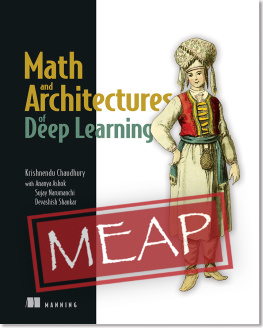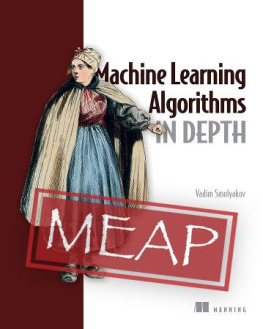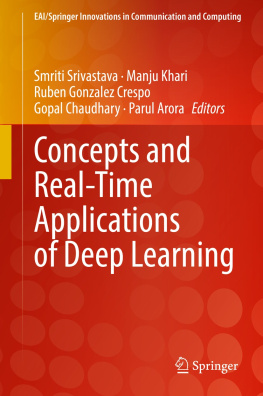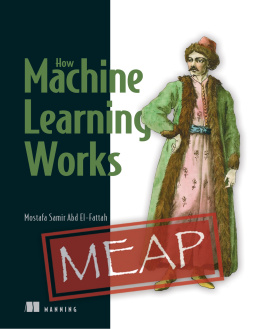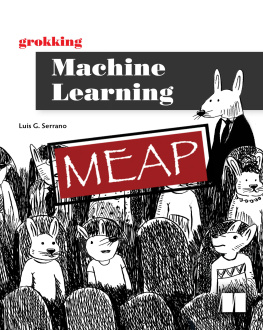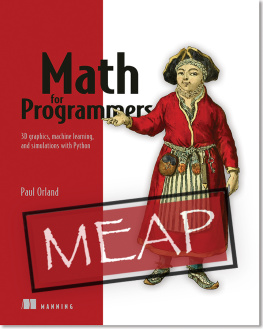Krishnendu Chaudhury - Math and Architectures of Deep Learning MEAP V02
Here you can read online Krishnendu Chaudhury - Math and Architectures of Deep Learning MEAP V02 full text of the book (entire story) in english for free. Download pdf and epub, get meaning, cover and reviews about this ebook. year: 2020, publisher: Manning Publications Co., genre: Computer. Description of the work, (preface) as well as reviews are available. Best literature library LitArk.com created for fans of good reading and offers a wide selection of genres:
Romance novel
Science fiction
Adventure
Detective
Science
History
Home and family
Prose
Art
Politics
Computer
Non-fiction
Religion
Business
Children
Humor
Choose a favorite category and find really read worthwhile books. Enjoy immersion in the world of imagination, feel the emotions of the characters or learn something new for yourself, make an fascinating discovery.
- Book:Math and Architectures of Deep Learning MEAP V02
- Author:
- Publisher:Manning Publications Co.
- Genre:
- Year:2020
- Rating:3 / 5
- Favourites:Add to favourites
- Your mark:
- 60
- 1
- 2
- 3
- 4
- 5
Math and Architectures of Deep Learning MEAP V02: summary, description and annotation
We offer to read an annotation, description, summary or preface (depends on what the author of the book "Math and Architectures of Deep Learning MEAP V02" wrote himself). If you haven't found the necessary information about the book — write in the comments, we will try to find it.
Math and Architectures of Deep Learning MEAP V02 — read online for free the complete book (whole text) full work
Below is the text of the book, divided by pages. System saving the place of the last page read, allows you to conveniently read the book "Math and Architectures of Deep Learning MEAP V02" online for free, without having to search again every time where you left off. Put a bookmark, and you can go to the page where you finished reading at any time.
Font size:
Interval:
Bookmark:

MEAP Edition
Manning Early Access Program
Math and Architectures of Deep Learning
Version 2
Manning Publications Co. We welcome reader comments about anything in the manuscript - other than typos and other simple mistakes.
These will be cleaned up during production of the book by copyeditors and proofreaders.
https://livebook.manning.com/book/math-and-architectures-of-deep-learning/discussion
For more information on this and other Manning titles go to
www.manning.com
Dear Reader,
Welcome to Manning Early Access Program (MEAP) for Math and Architectures of Deep Learning. This membership will give you access to the developing manuscript along with the resources which includes fully functional python/PyTorch code downloadable and executable via Jupyter-notebook.
Deep learning is a complex subject. On one hand, it is deeply theoretical with extensive mathematical backing. Indeed, without a good intuitive understanding of the mathematical underpinnings, one is doomed to merely running off the shelf pre-packaged models without understanding them fully. These models often do not lend themselves well to the exact problem one needs to solve and one is helpless if any change or re-architecting is necessary. On the other hand, deep learning is also intensely practical requiring significant Python programming skills on new platforms like Tensorflow and PyTorch. Failure to master those leaves one unable to solve any real problem.
This author feels that there is a dearth of books that addresses both of these aspects of the subject in a connected fashion. That is what has led to the genesis of this book.
The author will feel justified in his efforts if these pages help the reader to become a successful exponent in the art and science of deep learning.
Sincerely,
Krishnendu Chaudhury
Are you the type of person who wants to know why and how things work? Instead of feeling satisfied, even grateful, that a tool is solving the problem at hand - you try to understand what the tool is really doing, why it is behaving in a certain way and whether it will work under changed circumstances? If yes, you have my sympathies - life wont be peaceful for you. You also have my best wishes - these pages are dedicated to you.
The internet abounds with various pre-built deep learning models and training systems that hardly require one to understand the underlying principles. But practical problems often do not quite fit any of the publicly available models. These situations call for development of a custom model architecture. Developing these require one to understand the mathematical underpinnings of optimization and machine learning.
A relevant question can be asked here. These (deep learning and computer vision) are, after all, very practical subjects. Is the mathematics really necessary? Shouldnt one rather spend the time learning, say the python nuances of deep learning? Well, yes and no. Programming skills, in particular python, are mandatory. But without an intuitive understanding of the mathematics, the how and why and can I re-purpose this model will not be visible to the practitioner. In short, mathematics allows you to see the abstractions behind the implementation.
In many ways, the ability to form abstractions is the essence of higher intelligence. It is abstraction that enabled early humans to divine a digging and defending tool in what was merely a sharply pointed stone to other animals. The abstraction of the description of where something is with respect to some other thing fixed in the environment (aka coordinate systems and vectors) has done wonders to human civilization. Mathematics is the language for abstractions, the most precise, succinct and unambiguous known to humankind.
Having (hopefully) made a case for studying the underlying mathematical principles of deep learning and computer vision, we would hasten to add that mathematical rigor is not the goal here. Rather, the goal is to provide mathematical, in particular, geometrical, insights that make the subject more intuitive and indeed less of a black magic. At the same time, we will provide python coding exercises and visualization aids throughout - thus these pages can be regarded as learning mathematical foundations of deep learning via geometrical examples and python exercises.
Fully functional detailed code backing the theory discussed in the book is provided via Jupyter-notebook at https://github.com/krishnonwork/mathematical-methods-in-deep-learning-ipython . Also, important snippets from the full code have been inserted in the body of the main book for illustration purposes - these are not fully functional.
Mastery over the material presented in this book will enable the reader to
Understand state-of-the-art deep learning research papers. In fact, the book will attempt to provide in-depth, intuitive understandings of all the seminal papers of the day.
Study and understand a deep learning code-base
Directly lift off code snippets from the book to use in their tasks
Ace an interview for ML engineer/scientist
Determine whether a real life problem is amenable to machine/deep learning
Troubleshoot neural network quality issues
Identify the right neural network architecture to solve a real life problem
Quickly implement a prototype architecture and train a deep learning model for some real life problem
A word of caution. We will often start at the basics but quickly move deeper. It is kind of important to read individual pieces end to end, even if one is familiar with the material presented at the beginning.
Finally, the ultimate justification of an intellectual endeavor is that one had fun pursuing it.
So, the author would consider himself successful if you enjoy reading these lines.
Deep learning has transformed computer vision, natural language and speech processing in particular and artificial intelligence in general. From a bag of semi-discordant tricks, none of which worked satisfactorily on a real life problem, artificial intelligence has become a formidable tool to solve real problems faced by industry, at scale. This is nothing short of a revolution going on under our very noses. If one wants to lead the curve of this revolution, it is imperative to understand the underlying principles and abstractions, rather than simply memorizing the how to steps of some hands on guide. This is where the mathematics comes in.
In this first chapter we will give an overview of deep learning. This will require us to use some concepts that have been explained in subsequent chapters. The reader should not worry if there are some open questions at the end of this chapter. This chapter is aimed at orienting ones mind towards this difficult subject. As individual concepts get clearer in subsequent chapters, the reader should consider coming back and giving this chapter a re-read.
Making decisions and/or predictions is a central requirement of life. This essentially involves taking in a set of sensory or knowledge inputs and generating decisions or estimates by processing them.
For instance, a cats brain is often trying to choose between the following options: run away
Next pageFont size:
Interval:
Bookmark:
Similar books «Math and Architectures of Deep Learning MEAP V02»
Look at similar books to Math and Architectures of Deep Learning MEAP V02. We have selected literature similar in name and meaning in the hope of providing readers with more options to find new, interesting, not yet read works.
Discussion, reviews of the book Math and Architectures of Deep Learning MEAP V02 and just readers' own opinions. Leave your comments, write what you think about the work, its meaning or the main characters. Specify what exactly you liked and what you didn't like, and why you think so.

